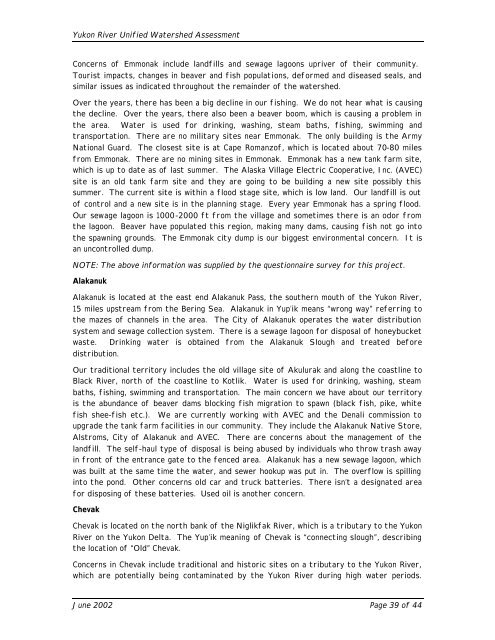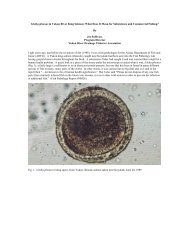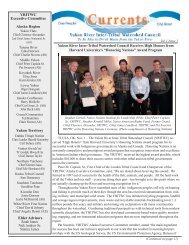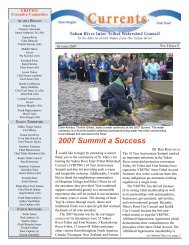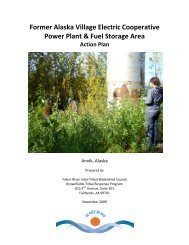Yukon River Unified Watershed Assessment - Yukon River Inter ...
Yukon River Unified Watershed Assessment - Yukon River Inter ...
Yukon River Unified Watershed Assessment - Yukon River Inter ...
You also want an ePaper? Increase the reach of your titles
YUMPU automatically turns print PDFs into web optimized ePapers that Google loves.
<strong>Yukon</strong> <strong>River</strong> <strong>Unified</strong> <strong>Watershed</strong> <strong>Assessment</strong><br />
Concerns of Emmonak include landfills and sewage lagoons upriver of their community.<br />
Tourist impacts, changes in beaver and fish populations, deformed and diseased seals, and<br />
similar issues as indicated throughout the remainder of the watershed.<br />
Over the years, there has been a big decline in our fishing. We do not hear what is causing<br />
the decline. Over the years, there also been a beaver boom, which is causing a problem in<br />
the area. Water is used for drinking, washing, steam baths, fishing, swimming and<br />
transportation. There are no military sites near Emmonak. The only building is the Army<br />
National Guard. The closest site is at Cape Romanzof, which is located about 70-80 miles<br />
from Emmonak. There are no mining sites in Emmonak. Emmonak has a new tank farm site,<br />
which is up to date as of last summer. The Alaska Village Electric Cooperative, Inc. (AVEC)<br />
site is an old tank farm site and they are going to be building a new site possibly this<br />
summer. The current site is within a flood stage site, which is low land. Our landfill is out<br />
of control and a new site is in the planning stage. Every year Emmonak has a spring flood.<br />
Our sewage lagoon is 1000-2000 ft from the village and sometimes there is an odor from<br />
the lagoon. Beaver have populated this region, making many dams, causing fish not go into<br />
the spawning grounds. The Emmonak city dump is our biggest environmental concern. It is<br />
an uncontrolled dump.<br />
NOTE: The above information was supplied by the questionnaire survey for this project.<br />
Alakanuk<br />
Alakanuk is located at the east end Alakanuk Pass, the southern mouth of the <strong>Yukon</strong> <strong>River</strong>,<br />
15 miles upstream from the Bering Sea. Alakanuk in Yup’ik means “wrong way” referring to<br />
the mazes of channels in the area. The City of Alakanuk operates the water distribution<br />
system and sewage collection system. There is a sewage lagoon for disposal of honeybucket<br />
waste. Drinking water is obtained from the Alakanuk Slough and treated before<br />
distribution.<br />
Our traditional territory includes the old village site of Akulurak and along the coastline to<br />
Black <strong>River</strong>, north of the coastline to Kotlik. Water is used for drinking, washing, steam<br />
baths, fishing, swimming and transportation. The main concern we have about our territory<br />
is the abundance of beaver dams blocking fish migration to spawn (black fish, pike, white<br />
fish shee-fish etc.). We are currently working with AVEC and the Denali commission to<br />
upgrade the tank farm facilities in our community. They include the Alakanuk Native Store,<br />
Alstroms, City of Alakanuk and AVEC. There are concerns about the management of the<br />
landfill. The self-haul type of disposal is being abused by individuals who throw trash away<br />
in front of the entrance gate to the fenced area. Alakanuk has a new sewage lagoon, which<br />
was built at the same time the water, and sewer hookup was put in. The overflow is spilling<br />
into the pond. Other concerns old car and truck batteries. There isn’t a designated area<br />
for disposing of these batteries. Used oil is another concern.<br />
Chevak<br />
Chevak is located on the north bank of the Niglikfak <strong>River</strong>, which is a tributary to the <strong>Yukon</strong><br />
<strong>River</strong> on the <strong>Yukon</strong> Delta. The Yup’ik meaning of Chevak is “connecting slough”, describing<br />
the location of “Old” Chevak.<br />
Concerns in Chevak include traditional and historic sites on a tributary to the <strong>Yukon</strong> <strong>River</strong>,<br />
which are potentially being contaminated by the <strong>Yukon</strong> <strong>River</strong> during high water periods.<br />
June 2002 Page 39 of 44


